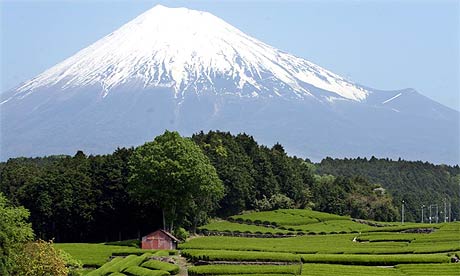
It is not only the most recognisable symbol of Japan, but according to one of its greatest admirers, a regular visual dose of Mount Fuji's perfectly conical slopes is the key to a sunnier disposition.
Simply staring at a photograph of Mt Fuji, Japan's highest peak, is enough to lift depression - or at the very least banish trivial worries - Rocky Tanaka, a photographer who has been snapping the mountain all his professional life, claims in an essay published this month.
Tanaka bases his theory, promoted in the medical magazine Sokai, on decades of observing reactions to his photographs, which have been called modern-day versions of the Hokusai's Thirty-Six Views of Mt Fuji, a series of woodblock prints from the early 19th century.
Some experts agree that images of Mt Fuji, an active volcano that last erupted in 1707, may well act as a balm for tortured souls.
"I'd say there probably are some positive effects," Dr Toshiaki Goto told the Asahi Geino, a weekly magazine better known for peddling stories about sex and celebrities.
Looking at the sun rising over Mt Fuji could provide a rush of adrenalin in the morning, sparking the sympathetic nerves into producing a morning dose of motivation, Goto said.
"Seeing a photo of the afternoon sun near Mount Fuji is likely to produce a substance called acetylcholine ... which leaves the viewer feeling relaxed," he added. "But I think looking at the actual Mount Fuji would be much more beneficial."
Watching the sunrise from the summit of the 3,776-metre peak is a spiritual rite of passage for many Japanese, although of the estimated 200,000 people who make the ascent every year, just under a third are from overseas.
The revered mountain is the subject of countless works of art and poetry, and is a traditional backdrop, in mural form, in old-fashioned public baths. According to folklore, the appearance of Mt Fuji, a hawk and an aubergine – admittedly an unlikely combination - in a dream on New Year's Day brings good luck for the rest of the year.
But other health experts are sceptical of Tanaka's claims. "As a doctor, I don't think it's possible to say that merely looking at a photo of Mt Fuji will clear up any health problems," Kazuo Sakai, a doctor at a mental health clinic in Tokyo, told the magazine. "But I wouldn't completely rule it out, either."
Despite its supposed life-affirming qualities, Mt Fuji also occupies a darker corner of the Japanese consciousness.
Its foothills provided a suitably secluded location for the headquarters of the Aum Shinrikyo doomsday cult, whose 1995 sarin gas attack on the Tokyo underground killed 12 people and injured thousands of others.
And Aokigahara, an ancient forest at the base of the mountain, is Japan's most infamous suicide spot.

